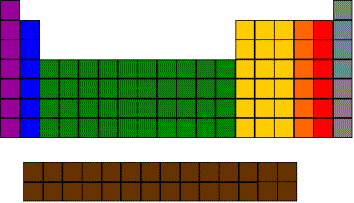Element Project
A WebQuest for High
School Chemistry
Designed by
Charlotte M. Trout
mailto:
troutcha@wcboe.k12.md.us

Introduction
| Task | Process | Evaluation
| Conclusion | Credits
Introduction
By now, you have learned about the structure of the atom and understand
something about the location of electrons within the electron cloud around
the nucleus. You know that an element is composed of a single type
of element. So how many elements are there? How do chemists
keep them all straight? What makes one element different from another?
Are any elements identical in their behavior and properties?
To begin to answer these questions,
you'll investigate one atom thoroughly and share that information with
your classmates.
The Task
You will use the internet and any other resources to research some properties
of an element assigned to you. You will:
-
turn in a page which contains all the requested information about the element
and elements in general;
-
create a visual project (poster, mobile or computer presentation) which
conveys some of the information;
-
enter some of the information into a database or onto an index card for
use in a later activity.
The Process
To accomplish the task, you will
need to follow several steps:
-
An element will be assigned to you
or you will choose an element from a list.
-
Use the web sites, print materials in
the classroom and the media center, or your textbook to complete the research
guide sheet. You should check at least two different web sites or be
sure that the web site you are using is supported by a trustworthy agency
before writing that information down. You should keep a list of all
resources use (a bibliography) and note which site was used for each piece
of information.
-
Prepare a poster, mobile, web page or
multimedia presentation which displays the following information about
your element.
-
Name of the element
-
Symbol and its origin
-
Discovery Date and who discovered it
-
Atomic number and weight
-
Electron configuration
-
Boiling point and melting point
-
Standard state of the element
-
Some useful or everyday products which
are made from this element
-
Enter the following data into an electronic
database or onto a card:
-
Atomic number
-
Atomic weight
-
Melting Point
-
Boiling Point
-
Standard State of the element
-
Electron configuration
-
Common oxidation number(s)
-
Common oxide formula(s)
-
Common chloride formula(s)
-
Acid/base behavior of oxide
Periodic Table Web
Sites - Good for Information about the Elements
Most of these sites allow you to
click on the element symbol shown within a periodic table and that will
open a page (or more) of information about the element.
About Chemistry.com
ACS Periodic Table
ChemCollective Periodic Table
Chemical
Elements.com
Chemicool
Periodic Table
Environmental
Chemistry.com
Jefferson
Lab Periodic Table of the Elements
Lenntech
Periodic Table of the Elements- Health and Environmental Effects
Los
Alamos National Laboratory Periodic Table
Physics
2000 Periodic Table - There is a lot of cool stuff here but you need
to look around
Science
Park Periodic Table
ThinkQuest
Periodic Table
University
of British Columbia Periodic Table
Visual
Elements Periodic Table
WebElements Periodic Table
World of Molecules Periodic Table
Evaluation
Each student will be graded individually
using the following criteria. Though a four point scale is used to
evaluate each product, the actual score assigned to each may be a multiple
of 4. Notice that for the database entry, it is either done or not
(grade of 0).
|
Beginning
1 |
Developing
2 |
Accomplished
3 |
Exemplary
4 |
Score |
|
Research Guide
Sheet
|
Guide sheet is
less than 60% complete.
|
Guide sheet is
missing a few pieces of information.
|
Guide sheet is
complete.
|
Guide sheet is
complete and sections for discovery, products and/or concerns show extra
work..
|
12 |
|
Bibliography
|
Bibliography incomplete
and/or most items are not annotated.
|
Some facts are
not annotated and/or some references in the bibliography are poorly cited.
|
Every fact on
the guide sheet is annotated and bibliography is complete and all references
are properly cited.
|
Every fact
on research sheet is annotated and bibliography is complete and all references
are properly cited. Facts which are not as widely available have
multiple annotations and/or evaluation of sources.
|
4 |
|
Completeness and
Accuracy of Presentation
|
Presentation is
inaccurate and/or more than 40% of the requested information is missing.
|
Presentation is
accurate but some information is missing.
|
Presentation is
complete and accurate.
|
Presentation is
not only complete and accurate but includes multiple examples of products
or uses.
|
8 |
| Creativity
or Attractiveness of Presentation |
Use of color,
poor printing and/or use of media detracts from the presentation
.
|
Presentation
is visually adequate.
|
Presentation is
visually appealing.
|
Presentation is
very attractive and creative.
|
4 |
|
Data Base Entry
is Complete
|
-
|
-
|
Database entry
is complete.
|
-
|
2 |
Conclusion
Now you know a lot of information
about one element. In the next step, you will begin to look at a
large number of these elements and see how scientists organize all this
information. You will begin with the elements you and your classmates
have researched. You will also determine which part of the atoms
structure is responsible for most of these properties.
Credits & References
The image of the periodic table at
the top of the page was drawn by the web page author.
Last updated 10/18/08.
Based on a template from
The
WebQuest Page

